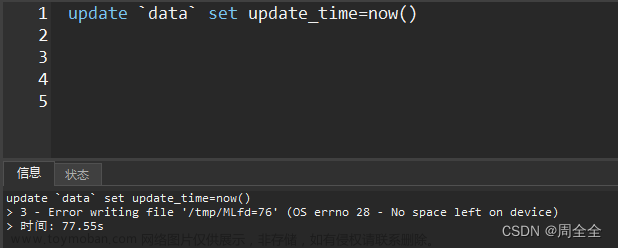1、确认本机是否有my.cnf文件
出现这个问题的原因有很多,我只说下我是怎么解决的。
首先看一下,你的mysql服务,有没有指定配置文件。
#进入mysql的bin目录,和你自己的安装位置有关系
/usr/local/mysql/bin
#执行如下命令
mysql --verbose --help | grep my.cnf
执行完之后,会输出几个可能的目录,你可以到各个目录下看看有没有my.cnf文件。如果没有,那就需要新建一个。
2、新建my.cnf文件
进入/etc目录,可能需要root权限,使用如下命令切换root用户,需要输入你进入mac的密码
sudo su -
然后在etc目录下新建一个my.cnf文件,复制如下内容到my.cnf文件中。
[client]
port = 3306 # default 3306
socket = %SOCKET% # Use mysqld.sock on Ubuntu, conflicts with AppArmor otherwise
[mysql]
no_auto_rehash
max_allowed_packet = 16M
prompt = '\u@\h [\d]> ' # 'user@host [schema]> '
default_character_set = utf8 # Possibly this setting is correct for most recent Linux systems
[mysqldump]
max_allowed_packet = 16M
[mysqld]
# Connection and Thread variables
port = 3306 # default 3306
socket = %SOCKET% # Use mysqld.sock on Ubuntu, conflicts with AppArmor otherwise
basedir = %BASEDIR%
datadir = /usr/local/mysql/data
# tmpdir = '%INSTANCEDIR%/tmp'
# innodb_tmpdir = '%INSTANCEDIR%/tmp' # MySQL 5.7 ff.
max_allowed_packet = 16M
default_storage_engine = InnoDB
# explicit_defaults_for_timestamp = 1 # MySQL 5.6 ff. default in MySQL 8.0, test carefully! This can have an impact on application.
# disable_partition_engine_check = true # Since MySQL 5.7.17 to 5.7.20. To get rid of nasty message in error log
# character_set_server = utf8mb4 # For modern applications, default in MySQL 8.0
# collation_server = utf8mb4_general_ci
max_connections = 151 # Values < 1000 are typically good
max_user_connections = 145 # Limit one specific user/application
thread_cache_size = 151 # Up to max_connections makes sense
# Query Cache (does not exist in MySQL 8.0 any more!)
# query_cache_type = 1 # Set to 0 to avoid global QC Mutex, removed in MySQL 8.0
# query_cache_size = 32M # Avoid too big (> 128M) QC because of QC clean-up lock!, removed in MySQL 8.0
# Session variables
sort_buffer_size = 2M # Could be too big for many small sorts
tmp_table_size = 32M # Make sure your temporary results do NOT contain BLOB/TEXT attributes
read_buffer_size = 128k # Resist to change this parameter if you do not know what you are doing
read_rnd_buffer_size = 256k # Resist to change this parameter if you do not know what you are doing
join_buffer_size = 128k # Resist to change this parameter if you do not know what you are doing
# Other buffers and caches
table_definition_cache = 1400 # As big as many tables you have
table_open_cache = 2000 # connections x tables/connection (~2)
table_open_cache_instances = 16 # New default in 5.7
# MySQL error log
log_error = %INSTANCEDIR%/log/%UNAME%_%INSTANCE%_error.log # Adjust AppArmor configuration: /etc/apparmor.d/local/usr.sbin.mysqld
# log_timestamps = SYSTEM # MySQL 5.7, equivalent to old behaviour
# log_warnings = 2 # MariaDB equivalent to log_error_verbosity = 3, MySQL does NOT support this any more!
# log_error_verbosity = 3 # MySQL 5.7 ff., equivalent to log_warnings = 2, MariaDB does NOT support this!
innodb_print_all_deadlocks = 1
# wsrep_log_conflicts = 1 # for Galera only!
# Slow Query Log
slow_query_log_file = %INSTANCEDIR%/log/%UNAME%_%INSTANCE%_slow.log # Adjust AppArmor configuration: /etc/apparmor.d/local/usr.sbin.mysqld
slow_query_log = 0
log_queries_not_using_indexes = 0 # Interesting on developer systems!
long_query_time = 0.5
min_examined_row_limit = 100
# General Query Log
general_log_file = %INSTANCEDIR%/log/%UNAME%_%INSTANCE%_general.log # Adjust AppArmor configuration: /etc/apparmor.d/local/usr.sbin.mysqld
general_log = 0
# Performance Schema
# performance_schema = ON # for MariaDB 10 releases
performance_schema_consumer_events_statements_history_long = ON # MySQL 5.6/MariaDB 10 and newer
# performance_schema_instrument = 'memory/%=COUNTED'
# Binary logging and Replication
server_id = %SERVERID% # Must be set on MySQL 5.7 and newer if binary log is enabled!
log_bin = %INSTANCEDIR%/binlog/%UNAME%_%INSTANCE%_binlog # Locate outside of datadir, adjust AppArmor configuration: /etc/apparmor.d/local/usr.sbin.mysqld
# master_verify_checksum = ON # MySQL 5.6 / MariaDB 10.2
# binlog_cache_size = 1M # For each connection!
# binlog_stmt_cache_size = 1M # For each connection!
max_binlog_size = 128M # Make bigger for high traffic to reduce number of files
sync_binlog = 1 # Set to 0 or higher to get better write performance, default since MySQL 5.7
expire_logs_days = 5 # We will survive Easter holidays
# binlog_expire_logs_seconds = 432000 # MySQL 8.0, 5 days * 86400 seconds
binlog_format = ROW # Use MIXED if you want to experience some troubles, default since MySQL 5.7, MariaDB default is MIXED
# binlog_row_image = MINIMAL # Since 5.6, MariaDB 10.1
# auto_increment_increment = 2 # For Master/Master set-ups use 2 for both nodes
# auto_increment_offset = 1 # For Master/Master set-ups use 1 and 2
# Slave variables
log_slave_updates = 1 # Use if Slave is used for Backup and PiTR, default since MySQL 8.0
read_only = 0 # Set to 1 to prevent writes on Slave
# super_read_only = 0 # Set to 1 to prevent writes on Slave for users with SUPER privilege. Since 5.7, not in MariaDB
# skip_slave_start = 1 # To avoid start of Slave thread
# relay_log = %UNAME%_%INSTANCE%_relay-bin
# relay_log_info_repository = TABLE # MySQL 5.6, default since MySQL 8.0, MySQL only
# master_info_repository = TABLE # MySQL 5.6, default since MySQL 8.0, MySQL only
# slave_load_tmpdir = '%INSTANCEDIR%/tmp' # defaults to tmpdir
# Crash-safe replication Master
# binlog_checksum = CRC32 # default
# sync_binlog = 1 # default since 5.7.6, but slow!
# innodb_support_xa = 1 # default, depracted since 5.7.10
# Crash-safe replication Slave
# relay_log_info_repository = TABLE # MySQL 5.6, default since MySQL 8.0, MySQL only
# master_info_repository = TABLE # MySQL 5.6, default since MySQL 8.0, MySQL only
# relay_log_recovery = 1
# sync_relay_log_info = 1 # default 10000
# relay_log_purge = 1 # default
# slave_sql_verify_checksum = 1 # default
# GTID replication
# gtid_mode = ON # MySQL only, Master and Slave
# enforce_gtid_consistency = 1 # MySQL only, Master and Slave
# log_bin = %INSTANCEDIR%/binlog/%UNAME%_%INSTANCE%_binlog # In 5.6 also on Slave
# log_slave_updates = 1 # In 5.6 also on Slave
# Security variables
# local_infile = 0 # If you are security aware
# secure_auth = 1 # If you are security aware
# sql_mode = TRADITIONAL,ONLY_FULL_GROUP_BY,NO_ENGINE_SUBSTITUTION,STRICT_ALL_TABLES,NO_ZERO_IN_DATE,NO_ZERO_DATE,ERROR_FOR_DIVISION_BY_ZERO # Be careful changing this afterwards, NO_AUTO_CREATE_USER does NOT exist any more in MySQL 8.0
# skip_name_resolve = 0 # Set to 1 if you do not trust your DNS or experience problems
# secure_file_priv = '%INSTANCEDIR%/tmp' # chmod 750, adjust AppArmor configuration: /etc/apparmor.d/local/usr.sbin.mysqld
# MyISAM variables
key_buffer_size = 8M # Set to 25 - 33 % of RAM if you still use MyISAM
myisam_recover_options = 'BACKUP,FORCE'
# disabled_storage_engines = 'MyISAM,MEMORY' # MySQL 5.7, do NOT during/before mysql_upgrade, good for Galera!
# MEMORY variables
max_heap_table_size = 64M # Should be greater or equal to tmp_table_size
# InnoDB variables
innodb_strict_mode = ON # Default since MySQL 5.7, and MariaDB 10.4
innodb_buffer_pool_size = 128M # Go up to 75% of your available RAM
# innodb_buffer_pool_instances = 8 # Bigger if huge InnoDB Buffer Pool or high concurrency, desupported in MariaDB 10.5 ff.
innodb_file_per_table = 1 # Is the recommended way nowadays
# innodb_flush_method = O_DIRECT # O_DIRECT is sometimes better for direct attached storage
# innodb_write_io_threads = 8 # If you have a strong I/O system or SSD
# innodb_read_io_threads = 8 # If you have a strong I/O system or SSD
# innodb_io_capacity = 1000 # If you have a strong I/O system or SSD
innodb_flush_log_at_trx_commit = 2 # 1 for durability, 0 or 2 for performance
innodb_log_buffer_size = 16M # Bigger if innodb_flush_log_at_trx_commit = 0
innodb_log_file_size = 256M # Bigger means more write throughput but longer recovery time
# innodb_log_files_in_group = 2 # Desupported in MariaDB 10.6
# Since MariaDB 10.0 and MySQL 5.6
innodb_monitor_enable = all # Overhead < 1% according to PeterZ/Percona
# Galera specific MySQL parameter
# default_storage_engine = InnoDB # Galera only works with InnoDB
# innodb_flush_log_at_trx_commit = 2 # Durability is achieved by committing to the Group
# innodb_autoinc_lock_mode = 2 # For parallel applying
# binlog_format = row # Galera only works with RBR
# query_cache_type = 0 # Use QC with Galera only in a Master/Slave set-up, removed in MySQL 8.0
# query_cache_size = 0 # removed in MySQL 8.0
# log_slave_updates = ON # Must be enabled on ALL Galera nodes if binary log is enabled!
# server_id = ... # Should be equal on all Galera nodes according to Codership CTO if binary log is enabled.
# WSREP parameter
# wsrep_on = on # Only MariaDB >= 10.1
# wsrep_provider = /usr/lib/galera/libgalera_smm.so # Location of Galera Plugin on Ubuntu ?
# wsrep_provider = /usr/lib64/galera-3/libgalera_smm.so # Location of Galera v3 Plugin on CentOS 7
# wsrep_provider = /usr/lib64/galera-4/libgalera_smm.so # Location of Galera v4 Plugin on CentOS 7
# wsrep_provider_options = 'gcache.size = 1G' # Depends on you workload, WS kept for IST
# wsrep_provider_options = 'gcache.recover = on' # Since 3.19, tries to avoid SST after crash
# wsrep_cluster_name = "My cool Galera Cluster" # Same Cluster name for all nodes
# wsrep_cluster_address = "gcomm://192.168.0.1,192.168.0.2,192.168.0.3" # Start other nodes like this
# wsrep_node_name = "Node A" # Unique node name
# wsrep_node_address = 192.168.0.1 # Our address where replication is done
# wsrep_node_incoming_address = 10.0.0.1 # Our external interface where application comes from
# wsrep_sync_wait = 1 # If you need realy full-synchronous replication (Galera 3.6 and newer)
# wsrep_slave_threads = 16 # 4 - 8 per core, not more than wsrep_cert_deps_distance
# wsrep_sst_method = rsync # SST method (initial full sync): mysqldump, rsync, rsync_wan, xtrabackup-v2
# wsrep_sst_auth = sst:secret # Username/password for sst user
# wsrep_sst_receive_address = 192.168.2.1 # Our address where to receive SST
# Group Replication parameter
# default_storage_engine = InnoDB # Group Replication only works with InnoDB
# server_id = %SERVERID% # Should be different on all 3 nodes
# log_bin = %INSTANCEDIR%/binlog/%UNAME%_%INSTANCE%_binlog # Locate outside of datadir, adjust AppArmor configuration: /etc/apparmor.d/local/usr.sbin.mysqld
# binlog_format = ROW
# binlog_checksum = NONE # not default!
# gtid_mode = ON
# enforce_gtid_consistency = ON
# master_info_repository = TABLE
# relay_log_info_repository = TABLE
# log_slave_updates = ON
# slave_parallel_workers = # 1-2/core, max. 10
# slave_preserve_commit_order = ON
# slave_parallel_type = LOGICAL_CLOCK
# transaction_write_set_extraction = XXHASH64
# loose-group_replication_group_name = "$(uuidgen)" # Must be the same on all nodes
# loose-group_replication_start_on_boot = OFF
# loose-group_replication_local_address = "192.168.0.1"
# loose-group_replication_group_seeds = "192.168.0.1,192.168.0.2,192.168.0.3" # All nodes of Cluster
# loose-group_replication_bootstrap_group = OFF
# loose-group_replication_single_primary_mode = FALSE # = multi-primary
3、修改my.cnf文件
只需要修改3处配置。两个port,和一个datadir。
datadir一般是/usr/local/mysql/data,根据你自己的目录情况修改即可。
4、重启mysql、关闭mysql
重启mysql。文章来源:https://www.toymoban.com/news/detail-486521.html
/usr/local/mysql/support-files/mysql.server restart
再关闭mysql试试,应该就可以成功了文章来源地址https://www.toymoban.com/news/detail-486521.html
/usr/local/mysql/support-files/mysql.server stop
到了这里,关于mac m2停止mysql报错:ERROR! MySQL server PID file could not be found!的文章就介绍完了。如果您还想了解更多内容,请在右上角搜索TOY模板网以前的文章或继续浏览下面的相关文章,希望大家以后多多支持TOY模板网!











